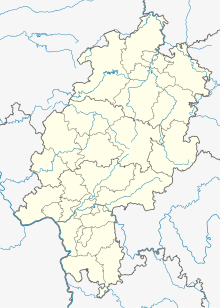Unfortunate things
Coordinates: 51 ° 11 ′ 10 ″ N , 9 ° 23 ′ 27 ″ E
Unseligendissen is a desert in the southwest of the district of Dissen , a district of Gudensberg in the north Hessian Schwalm-Eder district . During excavations around 1880, the remains of the settlement were found. The place name probably refers to an urn field from the Hallstatt period (800–450 BC), which was rediscovered during the construction of the Grifte – Gudensberg railway in 1898/99 . H. Non-Christians who had been buried.
Geographical location
The desert is halfway between Dissen and the core town of Gudensberg at an altitude of about 228 m , not far east of the district road K 6 and the federal motorway 49 at the Dissen / Gudensberg boundary. The striking Scharfenstein ( 304 m ) rises about 900 m to the north (beyond the autobahn), the Sonneborn spring, which is now set in natural stone, is located about 300 m to the northeast, and the Gothic Kasseler Kreuz at the junction of the K 6 from the K 7 is about 600 m southwest.
history
The small settlement was first mentioned in a document in 1307 as "Unselgenhusen", when the von Wolfershausen brothers transferred goods in the village to their relative, Konrad von Elben . Other landowners in the village were various noble families and religious institutions from the area. Hermann von Grone , cantor of the Petri-Stift zu Fritzlar , made considerable purchases of land in the district in 1311, 1314 and 1318: in 1311 he acquired the Ahnaberg monastery in Kassel, whose goods in Unseligendissen and Dorla for 50 marks pure silver ; 1314 from Gunther von Venne and his wife for 26 pounds and 10 shillings Fritzlar pfennigs their goods in Unseligendissen; also in 1314 from Johann von Venne his property in Unseligendissen; and also in 1314 three fields from the pleban Heinrich zu Bauna . In the same year 1314 Hermann bequeathed by Grone testamentary the monastery Haina significant real estate including accessories and rights, including three hooves to Unseligendissen whose income he intended for the poor in Fritzlar. In April 1318 liberated by Lowenstein-Schweinsberg her then in May of two of their vassals the Hermann von Grone, now Scholaster on Petri pin 75 Mark lehnsrührigen goods sold (2.5 hooves and 3 acres) to Unseligendissen of Lehnsbindungen ; In June, Hermann von Grone bequeathed these goods to the Haina monastery.
The 1322 even as a village called settlement discovered already in 1325 their last official mention, than that of the same Cistercian - Kloster Nordhausen in Kassel bequeathed their property to Unseligendissen. The last residents probably moved to the so-called "freedom" of the town of Gudensberg, which was favored by the landgraves' settlement policy and which was founded as an independent town in 1356, around the middle of the 14th century .
Footnotes
- ↑ Worth knowing along the way of the Josef-Mertin-Weg: Wüstungen near Dissen
- ↑ For another possible explanation of the place name, see Werner Guth: “Dissen, Deute, Haldorf, Ritte, Baune, Besse. . . “- Onomastic considerations on an old North Essian place name saying. In: Journal of the Association for Hessian History , Volume 116, 2011, pp. 1-20 (here: 6-7)
- ↑ The name of the place in written sources changed several times over the years: "Unselgenthosen" (1314), "Unselgent (h) usen" (1314), "Unselygentusin" (1314), "Unseligendhusen" (1318), "Unseligen Thusen "(1320)," Unseligentusin "(1322), and" Unseligen-Dissen ".
- ↑ In addition, 7 hooves in Kleinenglis , 2 hooves in Holzheim , a quarter of the goods previously owned by Werner von Züschen in Altendorf , 1 hoof in Lohne , 1 hoof and more in Dorla , and 2 hooves in Deute , all including accessories and rights. ( Hessisches Staatsarchiv Marburg: HStAM Fonds Urk. 26 No 1301 )
- ↑ Worth knowing along the way of the Josef-Mertin-Weg: Wüstungen near Dissen
literature
- Werner Ide: From Adorf to Zwesten. Local history pocket book for the Fritzlar-Homberg district. A. Bernecker, Melsungen, 1971, p. 68
- Waldemar Küther: Historical local dictionary Fritzlar-Homberg. Elwert, Marburg, 1980, ISBN 3-7708-0679-4 , pp. 56-57
- Georg Landau : Historical-topographical description of the desert towns in the Electorate of Hesse . Fischer, Kassel, 1858, p. 15
- Heinrich Reimer: Historical local dictionary for Kurhessen. Elwert, Marburg, reprint 1974, ISBN 3-7708-0509-7 , p. 91
Web links
- Unseligendissen, Schwalm-Eder-Kreis, in the Historisches Ortlexikon Hessen , accessed on January 29, 2020
